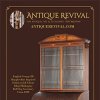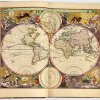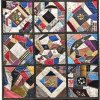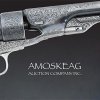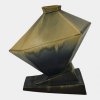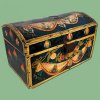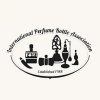Pots, Paintings, Pewter, and LSD
November 15th, 2015
Wooten & Wooten, Camden, South Carolina
Photos courtesy Wooten & Wooten
At the start of the second day of Wooten & Wooten’s fall Americana sale held November 14 and 15, 2015, most of the pottery collectors and dealers could be found standing at the back of the long narrow gallery. It was the perfect location to observe without being observed. The group set their sights on 45 mid- to late 19th-century jars and jugs from the Edgefield District of South Carolina, a place close to heaven for these pot heads. There were other pottery lots in the sale, but those with an Edgefield origin were the highly sought prizes. Most of the better pots came from the collections of Raymond Timmerman (d. 2015) and Ronny and Jane Meeks.
With their cards at the ready, bidders eyed the first lot, a rare tall, slender circa 1850 slip-decorated churn from the Thomas Chandler pottery, and passed. No one in the gallery, on the phones, or on the Internet popped for the low estimate of $10,000. They balked even when Wooten dropped the opening request to one-half the low estimate. “Its damage was likely the reason it passed,” said auctioneer Jeremy Wooten after the sale. “As wonderful and rare as the piece was, it simply wasn’t in great shape.”
 Wooten had better luck with the next lot, a 14¼" high circa 1850 slip-decorated merchant jar attributed to Collin Rhodes (1811-1881) from Edgefield’s Shaw’s Creek. When Wooten asked for $7500, the rush was on. No phone or Internet bidder had a chance. This belonged to the house.Tony Riley of Augusta, Georgia, bought the Rhodes jar for $19,200 (includes buyer’s premium). It was the top lot of the two-day sale.
Wooten had better luck with the next lot, a 14¼" high circa 1850 slip-decorated merchant jar attributed to Collin Rhodes (1811-1881) from Edgefield’s Shaw’s Creek. When Wooten asked for $7500, the rush was on. No phone or Internet bidder had a chance. This belonged to the house.Tony Riley of Augusta, Georgia, bought the Rhodes jar for $19,200 (includes buyer’s premium). It was the top lot of the two-day sale.
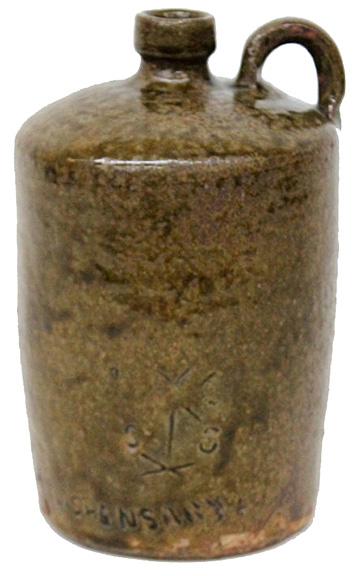
Probably more people checked out this circa 1893 dispensary jug than any other pot in the sale. The lure was a clearly visible incised palmetto palm and the stamp “SC / DISPENSARY.” It took a long time to move from the opening bid of $1700 to the final $10,800 (est. $3000/4000), a new record for this form. The 9" high jug was attributed to J.G. Baynham Pottery, Edgefield. Its new owner, Jim Williams of Greenville, South Carolina, was bidding on the Internet.
Wins by floor bidders waxed and waned over the next two hours, but in the end the house prevailed with over half of the 45 Edgefield lots. Winners on the phone and on the Internet tied at eight each. Absentees claimed four. Dealer Phil Wingard, who sells online at (www.edgefieldpottery.com), took home five of the Edgefield pots and at least three from other southern potteries.
A large 44-lot collection of 18th- and 19th-century pewter proved disappointing. Most lots were either passed or sold for one-half the low estimate. The house participated, but most of the bidding occurred on the phones where two slow and unenthusiastic bidders ruled. The top lot was five pewter plates by Boston makers that went to an absentee bidder for $600 (est. $300/500).
Three paintings ruled on the sale’s first day. Under the Silk Cotton Tree by Frank Earle Schoonover (1877-1972) illustrated a story in the July 1920 Ladies’ Home Journal. The oil on canvas descended in the William Walker family of Wilmington, Delaware. It opened with an absentee bid of $12,000, and no one answered. With buyer’s premium, it sold for $14,400. The same absentee bidder left a bid of $11,000 for a recently discovered oil on canvas signed by noted illustrator Howard Pyle (1853-1911). The painting appeared in an issue of Wide Awake for a serialized story that ran from December 1885 to October 1886. Again, no one answered the bid, and it sold for $13,200. Emanuel Gottlieb Leutze’s signed and dated (1857) oil on canvas of Colonial soldiers guiding townspeople with a covered wagon played out the same way but with a phone bidder. The Leutze opened and closed at $4800, one-half of its low estimate.
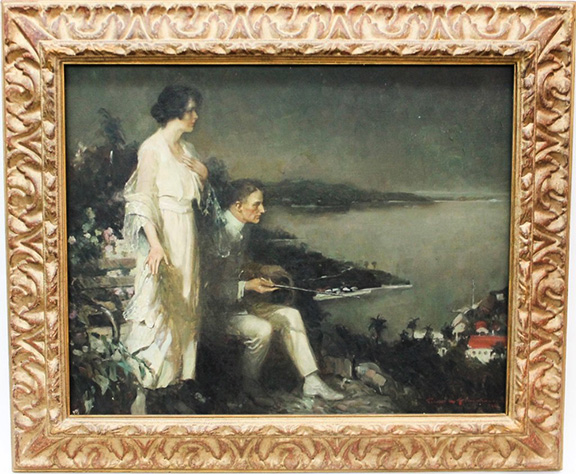
Frank Schoonover (1877-1972), a student of Howard Pyle, was famous for his Hopalong Cassidy and A Princess of Mars illustrations. His signed oil on canvas titled Under the Silk Cotton Tree was the top lot of the sale’s first day. It sold to an absentee bidder for $14,400 (est. $20,000/30,000).
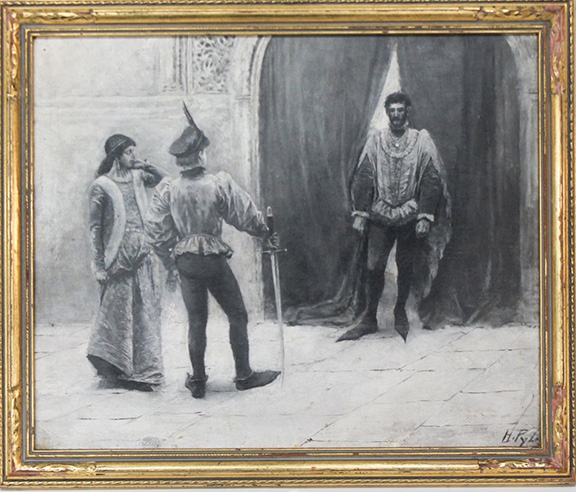
Art teacher and illustrator Howard Pyle (1853-1911) was noted for his extensive research into historic fashions and armaments. This 13½" x 16½" oil on canvas reflects some of that work. It sold to an absentee bidder for $13,200 (est. $20,000/30,000).
A Maryland tall-case clock brought the highest furniture price of the sale at $3600. Two southern furniture lots each sold for $2280. The first was a circa 1780 Chippendale servant’s desk in walnut from the Piedmont region of North Carolina. Its original dark, dry surface was intact. The interior was richly detailed, and the candle drawers that flanked the top center drawer supported the fall front. The second was an early 19th-century possibly Virginia-made Federal mahogany sideboard with a shaped backsplash. Cupboard doors at the center were flanked by a single cupboard door. The entire case sat on tapered square legs and spade feet.

The dial on this Federal tall-case clock is signed “Fred. Nusz Fred Town.” That’s Fredericktown, Maryland, where Frederick Nusz doubled as a clockmaker and silversmith. The circa 1816 clock has an eight-day time-and-strike movement housed in an 8'5" x 20½" x 9¾" case. It sold to the phones in quick order for $3600 (est. $3000/5000).
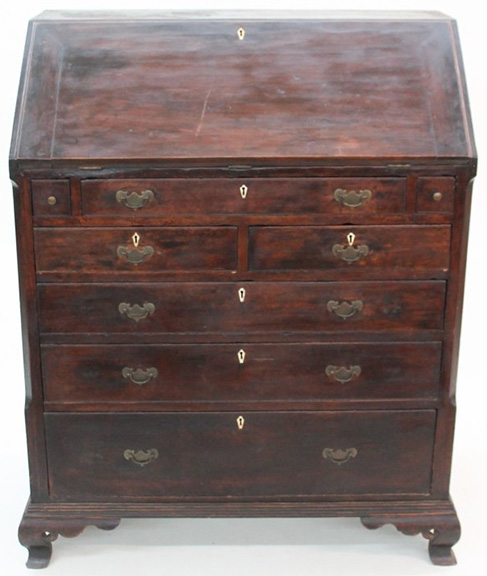
This 54" x 43" x 22" walnut servant’s desk from the North Carolina Piedmont sold below estimate to the Internet for $2280 (est. $3000/5000).
There was little doubt as to the most successful buyer on the sale’s first day. A Charleston, South Carolina, antiques dealer with a shop on King Street bought 57 lots while bidding on the phone. His or her purchases ranged from Windsor chairs and paintings to andirons and porcelain. Perhaps the most unusual and out-of-character purchase was three lots of pen-and-ink illustrations by North Carolina native Sidney Jackson Bartholomew Jr. (1953-2008). Bartholomew became famous as the art director and production designer for a number of Hollywood movies in the 1990s and early 2000s. During the bidding for Bartholomew’s illustration of a road trip to Grandfather Mountain with friends while on LSD, a bidder on the phone identified himself as one of the people depicted in the drawing. “I’m Dawg,” he said. Dawg was not as persistent as the Charleston dealer, who took the drawing for $420.
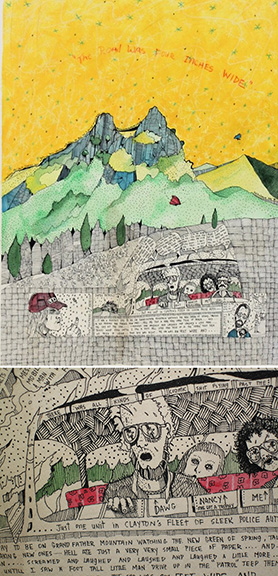
During the bidding for this 30" x 22¼" pen-and-ink drawing of a road trip to Grandfather Mountain in North Carolina, one of the passengers depicted in the car, the one Sidney Jackson Bartholomew Jr. labeled “Dawg,” called the auction house to bid on the drawing. Dawg dropped out of the running, and a Charleston, South Carolina, antiques dealer bought the drawing for $420 (est. $200/300). The psychoactive drug LSD was used on the trip.
For more information on Wooten & Wooten sales, visit the website (www.wootenandwooten.com) or phone (866) 570-0144.
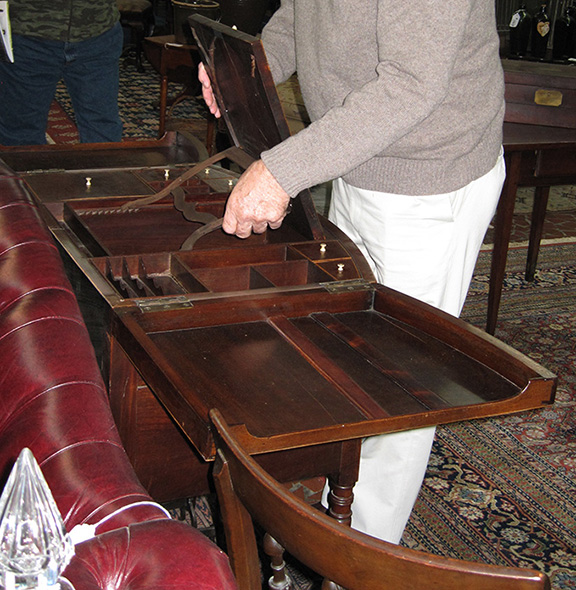
Charles Gay of Savannah, Georgia, is more an accumulator than collector. He liked this circa 1820 33½" x 29" x 19¾" “Beau Brummel” gentleman’s dressing stand with interior mirror and compartments under a double-hinged top. The stand quickly sold to a phone bidder for $1140 (est. $600/900). Prunkl photo.
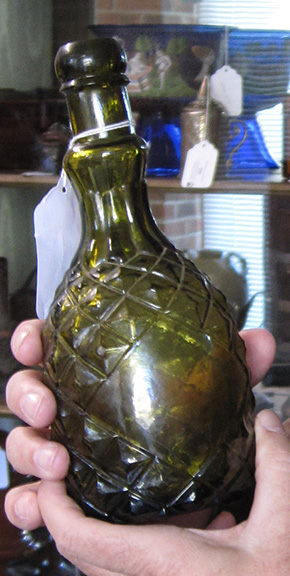
Herb Weaver of Savannah, Georgia, loves bottles and set his cap for this American yellow-green pineapple-form bitters bottle from the 1870s. It was Weaver and the Internet from the start. He hung in there past its high estimate but lost to an Internet bidder who bought the 9¼" tall bottle for $1440 (est. $600/900). Prunkl photo.
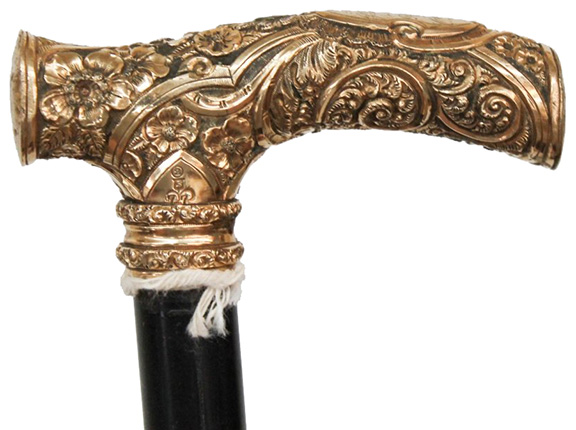
Of the 15 canes in the sale, this gold presentation cane from Charleston, South Carolina, topped all. It was presented to the Reverend J. Thomas Pate by the Palmetto Division of the local Order of Railway Conductors in March 1891. Three phones were active, and the 35?" tall cane went to one of them for $600 (est. $300/500).
Originally published in the February 2016 issue of Maine Antique Digest. © 2016 Maine Antique Digest
